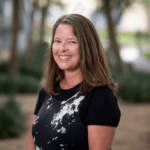The Gift of a Healthy Heart


Nasteho Adam, M.D., pushes Ilhan Salah Abdullahi through the concourse at George Bush Intercontinental Airport. Ilhan’s mother, Maryan Abdi Biriye, follows behind with two medics.
The hot pink poster, embellished with stickers, said “Welcome Ilhan.”
Rachael Wright, executive director of HeartGift-Houston, brought the homemade sign to George Bush Intercontinental Airport on Aug. 22 to greet a young Somali girl traveling to Houston for heart surgery.
But Ilhan Salah Abdullahi, 7, and her mother, Maryan Abdi Biriye, 39, did not arrive on their scheduled 6:51 p.m. flight. Anxious, Wright pulled out her phone and started a long conversation with British Airways, retracing the Nairobi-London-Dallas-Houston itinerary.
Four hours later, Ilhan and Maryan finally emerged from the gate. They had missed their connection in Dallas and had to wait for the next flight to Houston. And soon after take-off, Ilhan had a “tet” spell—not uncommon for children suffering from tetralogy of Fallot, a rare condition caused by four interrelated heart defects. A rapid drop in the amount of oxygen in Ilhan’s blood caused her tiny body to go limp and her skin to turn blue.
“She had no pulse for about 30 seconds,” said Quineshea Roberson, a member of the American Airlines crew on that flight. “She looked dead. She was in the back row of the plane and she wasn’t moving at all.”
Incredibly, a Somali cardiologist was on the flight and happened to be sitting near Ilhan. She checked Ilhan’s traveling papers, got her some oxygen, pumped her with fluids and spoke soothingly to Maryan and Ilhan in their native language.
“This mother and daughter—they have touched my heart,” said Nasteho Adam, M.D., who pushed Ilhan out of the gate in a wheelchair, with Maryan and two medics in tow.
Despite the 24-hour journey and the tet spell, Ilhan greeted Wright with wide eyes and a shy smile. Ayisha Warfa, a Somalian-born teacher who would be hosting Ilhan and Maryan at her home in Spring, joined Wright in the airport waiting area to greet her new houseguests.

Rachael Wright, left, executive director of HeartGift-Houston, holds a welcome sign for Ilhan and greets Ilhan’s mother, far right.
Within minutes, Wright had whisked the weary travelers away to collect their bags and get them settled into Warfa’s home. It was nearly midnight, and they had a doctor’s appointment at the Texas Medical Center the next morning.
Duck, duck, goose
Ilhan lives with her parents and nine siblings in a two-room mud hut in Garissa County, northeastern Kenya, near the Somalian border. Despite the Kenyan address, the family is Somali. Salah Abdullahi Ali, Ilhan’s father, works nights as a security guard, and Maryan works 20 hours a week as a janitor at a local school.
The family is poor. They have no electricity, no running water. Their bathroom is a hole in the ground behind their dwelling. There are no paved roads, trees or vegetation in their neighborhood, although some residents grow vegetables along a nearby river. A bus that comes from Nairobi, some 300 miles to the west, brings in food. Many Kenyan-Somalis in Garissa County must travel long distances to get medical care.
Ilhan was diagnosed with a heart condition at age one and has seen doctors intermittently, but it wasn’t until HeartGift selected her as a patient that surgery became a reality.
Established in Austin in 2000, HeartGift provides lifesaving surgery to children around the globe where specialized medical treatment is scarce or nonexistent. The organization, which has chapters in Austin, Houston, Dallas, San Antonio and Louisiana, has forged partnerships around the world to help get patient referrals. HeartGift staff and volunteers coordinate travel to the U.S., housing, meals, translators, entertainment—everything a child and parent will need for their stay. Building a solid social network around the parent and child is critical to a successful surgery and visit. For Ilhan and Maryan’s four-week stay, Wright reached out to Houston’s Somali population.
“It really takes a huge community,” Wright explained. “It’s kind of like duck, duck, goose. You tag a person who tags a person. … There’s a lot of text messaging and questions like: Can somebody bring a meal to the hospital? Is somebody available to visit them?”
Participating physicians and medical practices contribute 100 percent of their fees and services to HeartGift. In Houston, HeartGift works with doctors affiliated with Memorial Hermann Health System and The University of Texas Health Science Center (UTHealth).
This year, Ilhan was HeartGift-Houston’s fifth patient.
Floppy and listless
The morning after Ilhan and Maryan arrived in the U.S., Wright brought them to the office of John P. Breinholt III, M.D., chief of pediatric cardiology at Children’s Memorial Hermann Hospital.
Ilhan had to be measured and weighed before seeing the doctor: She was 43 inches tall and 33 pounds. Maryan sighed audibly when she heard just how little her daughter weighed. A test to show the amount of oxygen in Ilhan’s blood revealed she had half the amount she should.
While they waited in Breinholt’s office, Maryan sat with her daughter at a child-size table, pulling up a low chair so Ilhan, listless and floppy, could lean against her. Before long, Ilhan folded herself into her mother’s lap so swiftly and effortlessly that it was obviously a familiar, go-to position. Maryan cradled her as if she were an infant.
Translator Abdirisaq Abdulle stood by to help them communicate. When a technician came to give Ilhan an EKG, the young girl cried out in fear when she saw all the cords. It was the first sound she had made since arriving at the doctor’s office. Maryan leaned over the examining table to comfort her daughter as the translator explained that it wouldn’t hurt, that there would not be any blood.
When Breinholt arrived, he took Ilhan’s medical history and asked about the tet spell on the plane.
“Hello, beautiful,” he said to Ilhan, carrying her over to the examination table where he felt and listened to her heart.
“I’m feeling for a right ventricular heave coming up and pushing the chest wall,” said Breinholt, an associate professor and director of the division of pediatric cardiology at McGovern Medical School at UTHealth. “When you examine the heart, there’s a palpation element; there are murmurs you can feel. I can hear a gallop—an extra heart sound. Tetralogy means it’s a constellation of four findings. They’re actually all interrelated. It’s not like I would even call them four defects. One kind of causes the other.”
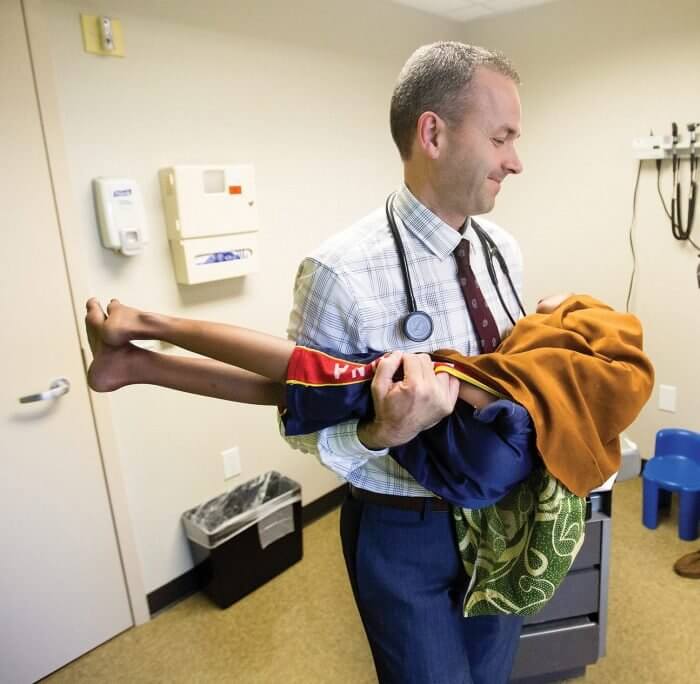
John Breinholt III, M.D., carries Ilhan to the examination table.
Tetralogy of Fallot denotes a problem between the two pumping chambers of the heart, also known as a ventricular septal defect. Additionally, the aortic valve is enlarged; the pulmonary valve is narrow and inhibits blood flow from the right ventricle to the pulmonary artery; and the walls of the right ventricle are thicker than they should be because the right ventricle is pumping at such high pressure—working overtime, all the time.
In patients with this condition, blood flow to the lungs is usually restricted and oxygen-poor blood is shunted from the right ventricle to the rest of the body. This oxygen-poor blood is darker than oxygen-rich blood, which is why the lips and skin of patients with tetralogy of Fallot appear blue.
“Ilhan’s oxygen saturation levels would never be allowed here in the U.S. without surgery or intervention or something like that,” Breinholt said, after the exam. “If you look at her fingers”—he walked across the room to where Ilhan was curled, once again, in her mother’s lap, and lifted one of her fingers—“her nail beds look kind of swollen, a little bulbous. That’s called clubbing. That’s the product of prolonged cyanosis—or prolonged blueness. Some of that will recede after she’s repaired. Her color will be vastly different after surgery. Even though she is very dark-complected, I can tell she’s cyanotic. Africans can be missed for this diagnosis.”
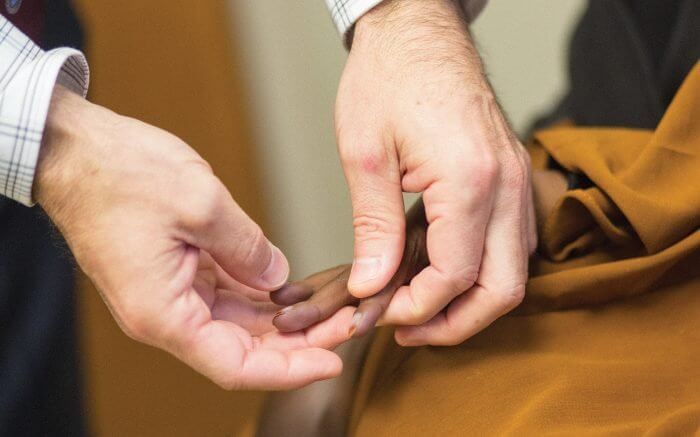
Breinholt examines Ilhan’s fingers.
In the coming days, though, the oxygen levels in Ilhan’s blood would only get worse. On top of that, a hurricane was heading toward Texas.
The best solution
On Friday, Aug. 25, Hurricane Harvey slammed into the Texas Gulf Coast. When the wind and water reached Houston, the Texas Medical Center found itself in the midst of an epic flood. Although hospitals remained open, access to the medical center was difficult. Many surgeries and routine treatments had to be rescheduled.
Jorge Salazar, M.D., started his new job at the Texas Medical Center on Sept. 1.
“It was such a whirlwind,” said Salazar, the new co-director of the Children’s Heart Center at Children’s Memorial Hermann Hospital, and professor and chief of the division of pediatric cardiovascular surgery at UTHealth’s McGovern Medical School. “I came from Boston to Houston to lead this program at Memorial Hermann. We were in Houston, living in a hotel, when the hurricane hit.”
Ilhan, who had been admitted to the hospital a few days earlier, was one of Salazar’s first patients.
“She had been waiting for surgery because of the hurricane,” Salazar said. “Her surgery had been planned for earlier. When I met her, her oxygen levels were under 50 percent, dropping to 40 percent. … Oxygen levels that are half of normal, of course, affect the brain and the rest of the body.”
So many babies and children needed care that Salazar and a team of doctors worked around the clock, sometimes performing two or three major operations a day. One surgery can last as long as six hours.
“We weren’t doing elective operations at that point, and Ilhan was one of the kids that needed urgent care,” he said. “We decided to operate on the weekend.” On Sunday, Sept. 3, Salazar and his team were able to fully repair Ilhan’s heart and to keep her pulmonary valve.
“Sometimes the best solution is the simple one,” Salazar explained. “When you do the repair, the crux of the issue is whether or not you can spare the pulmonary valve. The more we can respect the normal anatomy and function of her own heart, the better and the more durable the repair. Everything we do is about maximizing the benefits long term and minimizing the risk.
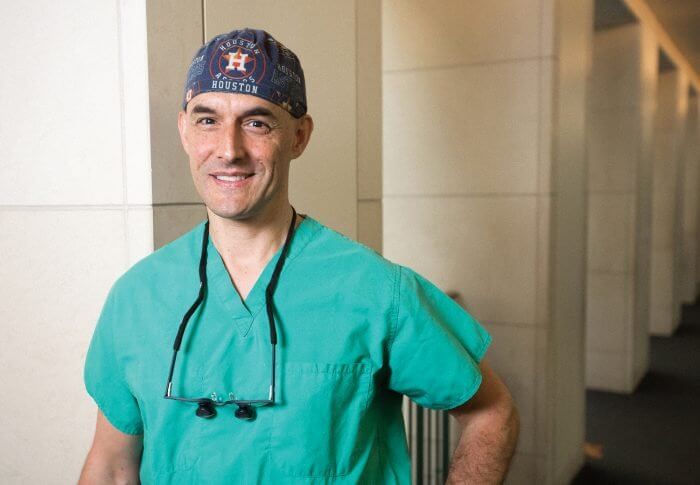
Jorge Salazar, M.D., started working at the Texas Medical Center on Sept. 1.
A dozen hard-boiled eggs
Four days after surgery, Ilhan sat up in bed in the hospital, eyes glued to “Family Guy” on television. Her once-blue lips were now pinkish-brown, and her skin had a healthier hue. She smiled when a stream of visitors arrived, but remained quiet.
Maryan, in a bright pink hijab, sat off to the side of her daughter. Speaking through an interpreter on a video remote interpreting machine, she answered questions about the surgery.
Were you afraid?
“Of course I was afraid, but I prayed to God that everything was going to be okay.”
Are you anxious to return to Africa?
“Yes, because all my other children are back home in Africa.
Can you describe your life there?
“The situation at home is horrible. It is very hot. But I don’t have any other choice but to go back.”
Can you describe your home?
“My house is made out of mud. Two rooms. About as big as this hospital room.”
Have you seen a change in Ilhan since the surgery?
“She’s able to breathe better. She is doing much better overall. Before the surgery, she was able to walk, but she would get tired after one or two steps. Since the surgery she has been able to walk without getting tired and walk a lot longer distance than before.”
All told, Ilhan spent more than a week in the hospital. Since she and her mother were stringent about what they would and would not eat, meals became a challenge. Becky Sam, RN, pediatric cardiovascular nurse coordinator at the hospital, ended up making food for Ilhan and storing it in a mini fridge at the hospital. Whether it was pasta with meat sauce or a dozen hard-boiled eggs, the meals and snacks lived in a large container labeled “Ilhan’s Food.”
By the time Ilhan left the hospital, the oxygen level in her blood was 100 percent.
Salazar said she was a patient he will never forget.
“I have seven children,” the surgeon said. “I take that same instinct of what I want for my own children and give that to the children I care for. It is impossible to imagine the stress and displacement Ilhan and her mother must have felt coming to such a different culture. I remember that her mother was so grateful. She was at her daughter’s bedside 24/7.”
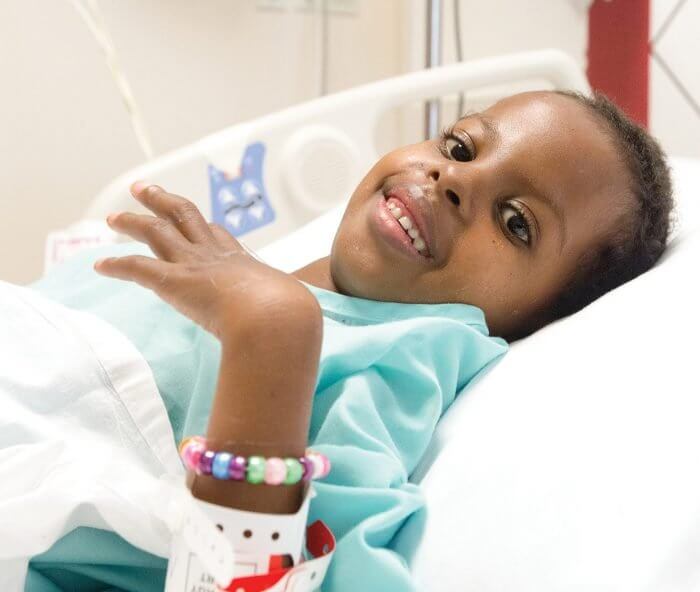
Ilhan smiles from her bed at Children’s Memorial Hermann Hospital a few days after surgery.
Bittersweet
Breinholt kept a close eye on Ilhan after surgery. Soon after discharge, she developed a fever and was readmitted to the hospital. It turned out that the fever was related to an ear infection, nothing more. Ilhan was sent back to Warfa’s home with a new antibiotic.
Breinholt, who has four children of his own, has cared for several HeartGift-Houston patients and taken more than 20 trips with different organizations to help children and families in underserved communities.
“We’re people they’ve never seen before and they can’t communicate with us like they’d like to,” Breinholt said. “These families are concerned, but they don’t ask a lot of questions. Many come from an environment where the prospect of losing a child is not as overwhelming as it might be for us. They tend to be understanding of those risks.”
Caring for children like Ilhan, who will return home and likely never see Breinholt or Salazar again, is bittersweet for both doctors.
“You have to set a different type of expectation,” Breinholt said. “How we look at it is: This is her only shot. They try to select cases where one surgery is going to be all the patient needs. This one was life-saving. Because we’ve done this, Ilhan has a very high likelihood to get married, to have children, a family. She’ll have a long and fruitful life.”
The prognosis for children like Ilhan has gotten markedly better over the past few decades, Salazar said.
“One percent of all babies born have a heart defect,” he said. “It’s really, really common. And it wasn’t that long ago that we didn’t have great solutions. Unfortunately, the vast majority would die before receiving care, especially outside the U.S. But over the last 15 years we have witnessed a transformation in the cases we can care for. More than 98 percent of the children who come to experienced centers like ours have excellent outcomes.”
For Ilhan, this was the opportunity of a lifetime, a surgical fix that will hopefully stick for decades to come. There will be no six-month or one-year checkups, though. That’s not her reality.
A pink crown
A modest, low-slung building behind Hillcroft Avenue began to fill with Somali women, carrying salads, spongy Ethiopian flatbread, fragrant trays of vegetables and meat, and thermoses of milky-sweet shaah hawash—a spiced tea loaded with cardamom, cloves and ginger.
Here at the Islamic Community Center, there were two reasons to celebrate: one woman was expecting a child, and Ilhan and Maryan were just days away from returning to Africa.

Ayisha Warfa displays her gift from HeartGift-Houston for hosting Ilhan and her mother. (Photo: Annie Mulligan)
A spacious shoe rack in the narrow entryway remained empty, while the floor below flooded with shoes hastily kicked off. Warfa, who had hosted Ilhan and Maryan for a month and introduced them to this circle of Muslim friends, marveled at the bond between this mother and daughter.
“You can tell the attachment level,” said Warfa, who came to the states 26 years ago to attend college in Manhattan and ended up starting a family in Texas. “I don’t know how anybody does it with 10 kids because everybody needs your attention. Maryan’s youngest is 6 months old. She left the baby with her sister, and when she gets back home she’s going to leave Ilhan with the same sister because she doesn’t want the younger or older kids, while they’re wrestling or playing, to hit her too hard.”
Ilhan, at age 7, is the same age as the first-graders Warfa teaches. “I’ve been taking Ilhan to Kohl’s,” Warfa said. “I bought her little girly dresses and stuff like that. She’s really enjoying those. Tomorrow we’re going to Target. Ilhan really likes the shopping. Maryan could care less.”
Women in jewel-toned hijabs and robes continued to arrive at the center, which hosts religious classes for children to learn the Koran. Many walked straight to a back room to pray, as the sun had already set.
Over the next few hours, the women visited in chairs lined up against the walls. Ilhan stayed close to Maryan, who stayed close to Warfa and Wright.
“I’d like to take a moment to thank Ayisha for hosting Ilhan and Maryan, for caring for them and translating over the phone at random times, and literally seeing them through a storm,” Wright said to the group, as she handed Warfa a small, wrapped present.
It was a photo of Ilhan from the hospital, wearing a pink crown that she had made herself.

Somalian women and other guests enjoy dinner at the Islamic Community Center. (Photo: Annie Mulligan)
As the women ate and talked—even breaking into song, at one point, pounding on chairs to keep the beat—Warfa explained that the community to which Ilhan and Maryan were returning was not unlike this tight-knit Somali group in Houston.
“They have a community of loving people and their relatives live close by,” Warfa said, adding that Maryan was somewhat mystified by American life.
At Warfa’s home one evening, Maryan said, “You have all this stuff, all these comforts, but where are your people? You go to work, come back home, park the car in the garage and then you’re inside the house for the rest of the evening. I don’t see anybody outside. There’s nobody. What’s going on? What kind of life is this?”
Maryan told Warfa that her African neighbors and friends helped care for Ilhan, and stuck together through difficult times.
“She told me they eat together,” Warfa said. “If somebody doesn’t have food one day, you can always find someone who will share what they have.”
As the evening wound down, Ilhan, who had been in and out of her mother’s lap, found a quiet spot by herself and polished off a piece of cake. The adults started to clean up.
Maryan looked over at her daughter, smiled, and said: “She’s tired. She wants to go home.”

Ilhan and Maryan, a few days before returning to Africa. (Photo: Annie Mulligan)

